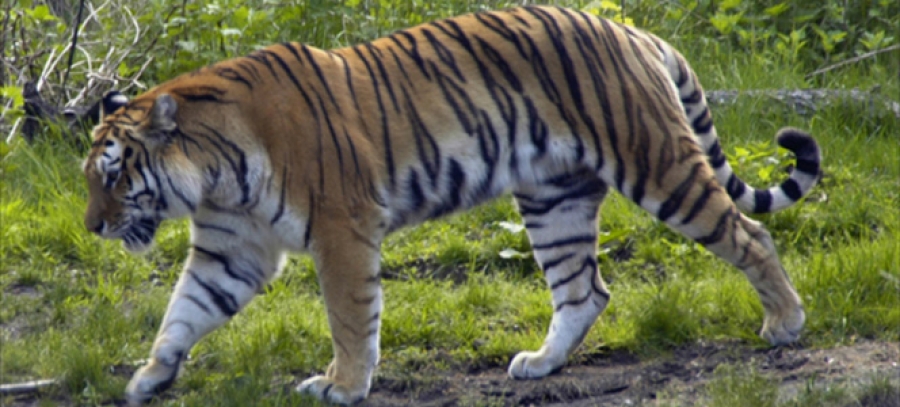The tiger (Panthera tigris) is the largest among all the living wild cats of the family Felidae. It has an elongated body, short neck, and compact head with a relatively short muzzle. The legs are stout and the paws are armed with retractile claws. The total body length of an adult male tiger is between 275-290 cm and that of an adult female is 250-260 cm. The adult male tiger weighs 180-260 kg whereas the adult female weighs 100-160 kg.
Tigers have a reddish-brown to rust-brown coat with black stripes and a white underbelly. Variations in coat colouration occur among individuals. White and black tigers are caused by a recessive gene.
Tigers are well known for their immense strength and power. They are known to bring down animals weighing almost ten times their own weight and then dragging them away to shelter. Their main prey species are herbivores, the favourites being Sambhar and Spotted deer. They eat an average of 5 kgs in a sitting and can eat up to 25 kgs in a day. A kill can feed a tiger for 2 - 4 days..Some experts say a tiger's kill success rate is as low as one out of ten attempts. Once it pounces on its prey, the tiger either kills it by snapping the spinal column at the neck as the animal is falling or by suffocating the victim by driving its sharp and long canines into the trachea. The tiger is also well equipped with sharp and retractable claws. These are mostly used for injuring, holding or cutting another animal but the power behind a tiger's slash is enough to kill too. Although the tiger prefers larger prey, it is not uncommon for it to kill small animals like monkeys, specially a mother with cubs. Tigers mostly do not try and make another kill immediately after finishing with the previous one. They usually give a 2-3 break before setting out on the next hunt. They have a life expectancy ranging from 15 - 20 years. Their breeding season begins towards the end of the monsoons and carries into the early months of winter. The mates stay together for a period of approximately 10 days. The gestation period is a short one of 105 days. Tigresses give birth to 3 - 6 cubs.
India holds over half the world's tiger population. Though referred to by experts as a "guesstimate", the last all-India census in 1993 estimated a total of 3,750 tigers. The figure was a sharp decline from the previous census four years earlier. Of these only 1,266 (34%) of the total were found within the boundaries of the then 19 (there are now 25, covering an area of over 33,000 sq km) Project Tiger Reserves. The current estimate of the number of tigers in India is from 3,000 to 3,500 tigers. Many of the tiger populations, particularly those outside protected reserves, are fragmented, suffer from intense poaching pressure, a dwindling prey base and over-used habitat. In India, the tiger is found practically throughout the country, from the Himalayas to Cape Comorin, except in Punjab, Kutch and the deserts of Rajasthan. In the northeast, its range extends into Burma. Tigers occupy a variety of habitats including tropical evergreen forests, deciduous forests, mangrove swamps, thorn forests and grass jungles.
